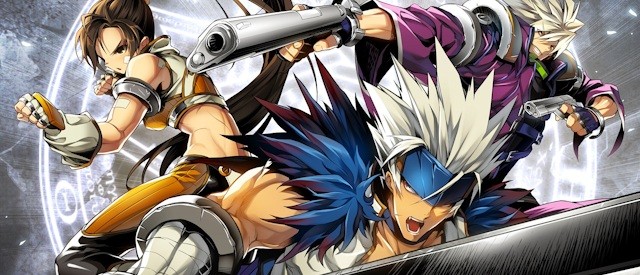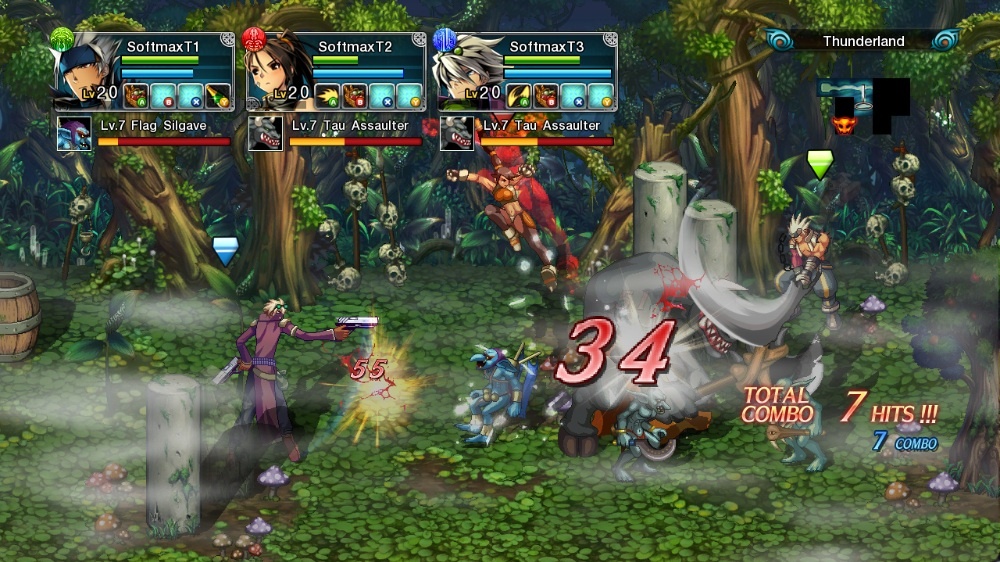

In all of gaming, there has been only one beat-em-up MMO: Dungeon Fighter Online, developed by NeoPle and published by Nexon. DFO is popular enough to have received both a 26-episode anime series and manga. We can now add an Xbox Live Arcade game to the list as well: Dungeon Fighter LIVE: The Fall of Hendon Myre. But how well fares an MMO with the massive taken out?
Don’t go into Dungeon Fighter LIVE expecting a story-focused experience like Guardian Heroes HD. Since the bulk of the game is adapted from an MMO – a genre in which stories and quests are usually briskly read-through or skipped by players in order to get on with the action, narrative definitely takes a back seat to grinding for XP and loot. The overarching story here works well enough, though. The land of Hendon Myre is suffering from a mysterious disease called Phantasmalia which drives people crazy before eventually killing them (and not by drilling a hole in their heads with a flying orb). Who is behind the menace – monsters or someone worse? A party of three Dungeon Fighters (adventurers) stumbles into the conspiracy and will unravel it by the game’s end.
While DFL is a quality game, awkward design decisions often hamper the experience. Take the tutorial – normally a good thing to include in a game, especially complex ones like this. Before you can join in an online game or start playing offline with your own character, you’ll have to go through a mandatory single-player tutorial. When you start a local multiplayer game, if even one player is starting a fresh character, then one player must go through the tutorial before everyone can play. If all four players already have established characters, starting a new character (each person can have five) still requires another replay of the tutorial. It’s not a long or difficult sequence, but forcing other players to sit idly while someone goes through it, and/or making someone who has already played with another character repeat the process just makes no sense.
After playing through the tutorial as ae warrior priest investigating the disease, you’ll take control of one of three character classes: the sword-based Slayer, the female martial artist Fighter, or the lanky range-focused Gunner. Each one has their own advantages like range, movement speed, and damage output. They will aso feel much more unique as you delve farther into the game and unlock new Skills. For example, the Fighter gets a devastating Suplex move that works even on screen-filling bosses, while the Slayer gains control of a djinni that provides an Area of Effect buff for the party. In the beginning Slayer will probably be the easiest class to play, but I hear Gunner gains the highest damage potential by the endgame.

DFL’s combat starts out deceptively simple and easy, to the point where the demo may seem underwhelming to beat-em-up enthusiasts. Standard attacks use only a single button (X) - surely a legacy of the game’s keyboard-friendly origins. The same button also picks up items, sometimes leading to interrupted combos as fighters accidentally scoop up trinkets during the heat of battle. Double-tapping left or right initiates a dash (great for getting around quickly), while the A button jumps. Jumping attacks are kind of slow and wonky, making jumps better suited for dodging projectiles for the most part.
Characters also begin with a single attack Skill attached to the B button. Every Skill consumes MP and has a brief cool-down period before it can be used again, so you can’t just spam the same Skill. Before long you’ll gain new Skills, greatly increasing your offensive and defensive options. These can be activated by either fighting-game like motions or hotkeying them to combinations of Right Bumper, Right Trigger, and the face buttons, making for a total of 8 hotkey slots. Single-use items can also be hotkeyed; you’ll want to have a healing item attached to one such slot at all times.
As you kill enemies, practically every one drops loot of some sort. This ranges from gold and consumable items to a huge selection of armor and class-specific weapons. Some armor even provides additional bonuses if you can find the whole set. Naturally, the color of the drop’s name denotes its rarity, with Legacy and Unique items the most uncommon. Before long, pots get thrown into the mix. Collect and then break them for a chance at finding choice equipment. As you can probably tell, DFL has a terrific loot system that encourages replaying areas in order to find new stuff. Sadly, you can’t organize your loot in any way, but at least the best items are listed at the top of the Equipment screen.
Instead of traditional linear levels, DFL’s stages more closely resemble MMO dungeons. Each one consists of a series of interlinked rooms. As you visit them, the layout appears on a minimap at the top corner of the screen. Dungeons end with a clearly-designated boss room – it’s up to you whether you want to explore the entire thing or just head straight for the boss. Every dungeon comes in three (and later four) difficulties. After completing the Beginner version and any associated quests, you’ll unlock the Master version, and so on. Layouts don’t change at all between difficulties, but the quantities of enemies and their levels, drops, and completion rewards certainly increase in the harder versions.
Between dungeons, visit the friendly town blacksmith (center) and rapist (at right).
Trips to town precede and punctuate just about every run through a dungeon. Towns look a bit different than in Dungeon Fighter Online, as they’re now menu-based and no longer populated by other players. While those aspects are missed, the streamlined version makes finding NPCs and getting your business done a fairly quick process. Most NPCs sell a particular kind of item and can repair any equipment damaged in battle. Remembering to repair your stuff is paramount because weapons and armor lose all effectiveness when their durability points expire. NPCs also bestow quests, which consist of MMO mainstays like killing X number of enemies or finding Y number of items. Nothing too fancy, but they’re worth doing for both the rewards and to unlock new dungeons.
Having covered the meat of the game, let’s focus on the multiplayer. First, the good: Dungeon Fighter LIVE supports any combination of local and online players in 4-player co-op. You’ll face the same number of enemies no matter how large your party, so playing with a group definitely makes things easier. Completing dungeons in a local party offers an XP bonus, while online parties get an even bigger bonus. Everyone gets Achievements, even in local games.
Now we return to those awkward design decisions I mentioned earlier. DFL only contains three of the PC game’s six primary classes – presumably so that the others can be sold as DLC at a later date. Understandable given the XBLA game’s low price, but it’s strange to only offer three classes in a 4-player game. Full games will always have double of at least one class. Worse, you can’t even visually distinguish characters. It would be so easy to at least allow players to select their own color pallets as a form of personalization, but instead every player looks identical. I’ve actually been in online matches consisting of four Fighters or four Slayers, each one differentiated only by the colored triangle floating above everyone's heads. Heck, even the freemium PC game lets players buy visual customizations with real money. Why can’t LIVE do the same? (The only PDLC so far is Resurrection Stones, which function as extra lives during dungeons and are mandatory for completing the final level.)
Considering DFL’s online multiplayer focus, the online partying system is also inexplicably obtuse. When you set out to take on a dungeon, you can form a party either by inviting friends or matchmaking. The problem lies after completing the dungeon and returning to town. Every single time you go to town – necessary for a number of reasons, including repairing equipment – the party disbands. To play with the same group of people after you’ve done your business, you’ll have to invite them all over again. The need to constantly break up and reform the party makes what should be a simple process needlessly complicated and time-consuming. At the very least, you’ll want to keep everyone in an Xbox Live Party to coordinate the invite process.
Strange as it seems, local multiplayer fares much better since offline parties can return to town as a group. Whenever a player enters the menu, whether in a town or dungeon, everyone else does so as well. Each person gets their own quarter-screen menu, making it easy to equip your gear, etc. while the others do the same. Gameplay only resumes once everyone readies up. Local multiplayer would be just about ideal if not for one major annoyance: the item trading interface. Trading can only be done from the party screen right before entering an area and is far from intuitive. You can’t even move items between your own characters directly – that would necessitate trading the item to someone else and then coming back with another character to receive the item. A proper trade interface and/or bank system would have made the game a fair bit better.
Dungeon Fighter LIVE: The Fall of Hendon Myre is a good game that could have been a great one if only it had a better director or producer on hand to smooth out its kinks. The inability to keep online parties together between dungeons, customize character appearances, and trade items between characters are all such obvious oversights that anyone who’s played an online RPG before could spot in an instant. But don’t let these complaints scare you away from the game. DFL is a vast adventure that can easily provide 20 or more hours of action-RPG entertainment. Like any beat-em-up it particularly shines in local co-op. If you’re a fan of loot hunts like Phantasy Star Online and Diablo, you could easily find yourself addicted to DFL as well.